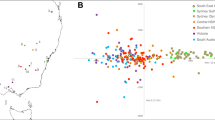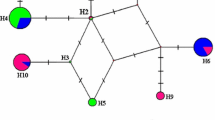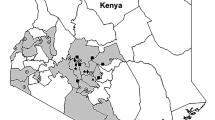Abstract
Eucalyptus is one of the most planted tree genera across the world, but is heavily challenged by invasive insect pests originating from the native range of these trees. The rate of introduction of non-native Eucalyptus-feeding insects has increased globally, including in sub-Saharan Africa where Eucalyptus trees have an important socio-economic role. In this study, we mapped the distribution and examined the genetic diversity of non-native Eucalyptus insect pests in 14 countries across sub-Saharan Africa. We focused on five foliage-feeding insect pests of Eucalyptus which are known to be present in the region, namely the bluegum chalcid wasp, Leptocybe invasa; the redgum lerp psyllid, Glycaspis brimblecombei; the bronze bug, Thaumastocoris peregrinus; the Eucalyptus weevil, Gonipterus sp.n.2; and the Eucalyptus gall wasp, Ophelimus maskelli. Insect samples were collected through structured surveys and small-scale sampling which were both combined with published literature to determine the distribution of these insect pests. Genetic diversity of each of these insect pests was estimated/assessed based on mitochondrial cytochrome oxidase I (COI) or cytochrome b (Cyt b) sequence data. Except O. maskelli, which is a relatively recent arrival, the other insect pests were found broadly distributed across the sampled countries, with first reports in many countries. Analysis of genetic diversity confirmed a common origin of geographically distant populations for G. brimblecombei and O. maskelli, moderate diversity for T. peregrinus and Gonipterus sp.n.2 and at least two distinct lineages for L. invasa. Two divergent haplogroups of L. invasa, with overlapping geographic range were confirmed in Ghana, Malawi, Sierra Leone, South Africa and Zimbabwe. Compared to published literature, new haplotypes were detected for T. peregrinus, Gonipterus sp.n.2 and L. invasa, suggesting multiple introduction of those pests in the region. Results of this study will have implications for quarantine, management and future research of Eucalyptus insect pests in the region and beyond.





Similar content being viewed by others
References
Asfaw BA (2018) First record of Eucalyptus Gall Wasp (EGW) (Ophelimus maskelli (Ashmead) on Eucalyptus camaldulensis in Ethiopia. Int J Agric For 8:112–117
Bandelt H-J, Forster P, Röhl A (1999) Median-joining networks for inferring intraspecific phylogenies. Mol Biol Evol 16:37–48
Bella S, Rapisarda C (2013) First Report from Greece of the invasive red gum lerp psyllid Glycaspis brimblecombei Moor (Hemiptera Psyllidae) and its associated parasitoid Psyllaephagus bliteus Riek (Hymenoptera Encyrtidae). Redia 96:33–35
Bennett BM, Kruger FJ (1983) Forestry and water conservation in South Africa: history, science and policy. World forest history series. The Australian National University (ANU) Press, Canberra, pp 1–265.
Branco M, Boavida C, Durand N, Franco JC, Mendel Z (2009) Presence of the eucalyptus gall wasp Ophelimus maskelli and its parasitoid Closterocerus chamaeleon in Portugal: First record, geographic distribution and host preference. Phytoparasitica 37:51–54
Burks RA, Mottern JL, Waterworth R, Paine TD (2015) First report of the eucalyptus gall wasp, Ophelimus maskelli (Hymenoptera: Eulophidae), an invasive pest on Eucalyptus, from the Western Hemisphere. Zootaxa 3926:448–450
Bush SJ, Slippers B, Neser S, Harney M, Dittrich-Schröder G, Hurley BP (2016) Six recently recorded Australian insects associated with Eucalyptus in South Africa. Afr Entomol 24:539–544
CABI (2018a) Invasive Species Compendium. Gonipterus scutellatus (Eucalyptus snout beetle). Accessed 26 Dec 2018. https://www.cabi.org/isc/datasheet/25719
CABI (2018b) Invasive Species Compendium. Phoracantha recurva (Eucalyptus longhorned borer). Accessed 26 Dec 2018. https://www.cabi.org/isc/datasheet/40371
CABI (2018c) Invasive Species Compendium. Thaumastocoris peregrinus (bronze bug). Accessed 26 Dec 2018. https://www.cabi.org/isc/datasheet/109741
Chungu D, Shakacite O, Chama H, Chungu BC, Mbindo K, Mulongwe L (2017) First record of the red gum lerp psyllid, Glycaspis brimblecombei Moore (Hemiptera: Psyllidae), in Zambia. Afr J Ecol 55:380–382
Csóka G, Stone GN, Melika G (2017) Non-native gall-inducing insects on forest trees: a global review. Biol Invasions 19:3161–3181
Dittrich-Schröder G, Hoareau TB, Hurley BP, Wingfield MJ, Lawson S, Nahrung HF, Slippers B (2018) Population genetic analyses of complex global insect invasions in managed landscapes: a Leptocybe invasa (Hymenoptera) case study. Biol Invasions 2018:1–26
FAO (2009) Global review of forest pests and diseases. A thematic study prepared in the framework of the Global Forest Resources Assessment 2005. FAO Forestry Paper 156, Rome, Italy
FAO (2011) Eucalyptus in East Africa, socio-economic and environmental issues, by Gessesse Dessie and Teklu Erkossa. Planted forests and trees working paper 46/E, Forest Management Team, Forest Management Division. FAO, Rome
Folmer O, Black M, Hoeh W, Lutz R, Vrijenhoek R (1994) DNA primers for amplification of mitochondrial cytochrome c oxidase subunit I from diverse metazoan invertebrates. Mol Mar Biol Biotechnol 3:294–299
Garcia A, Figueiredo E, Valente C, Monserrat VJ, Branco M (2013) First record of Thaumastocoris peregrinus in Portugal and of the neotropical predator Hemerobius bolivari in Europe. Bull Insectol 66:251–256
Garnas JR, Auger-Rozenberg M-A, Roques A, Bertelsmeier C, Wingfield MJ, Saccaggi DL, Roy HE, Slippers B (2016) Complex patterns of global spread in invasive insects: eco-evolutionary and management consequences. Biol Invasions 18:935–952
Garnas JR, Hurley BP, Slippers B, Wingfield MJ (2012) Biological control of forest plantation pests in an interconnected world requires greater international focus. Int J Pest Manag 58:211–223
Giliomee JH (2011) Recent establishment of many alien insecs in south Africa-a cause of concern. Afr Entomol 19:151–155
Gomy Y (2000) Nouvelle liste chorologique des coléoptères de l'archipel des Mascareignes. Société réunionnaise des Amis du Muséum
Hall T (1999) BioEdit: a user-friendly biological sequence alignment editor and analysis program for Windows 95/98/NT. Nucleic Acids Symp Ser 45:95–98
Harry M, Solignac M, Lachaise D (1998) Molecular evidence for parallel evolution of adaptive syndromes in Fig-Breeding Lissocephala (Drosophilidae). Mol Phylogenet Evol 9:542–551
Hurley BP, Garnas J, Wingfield MJ, Branco M, Richardson DM, Slippers B (2016) Increasing numbers and intercontinental spread of invasive insects on eucalypts. Biol Invasions 18:921–933
Hurley BP, Slippers B, Sathyapala S, Wingfield MJ (2017) Challenges to planted forest health in developing economies. Biol Invasions 19:3273–3285
Jacobs DH, Neser S (2005) Thaumastocoris australicus Kirkaldy (Heteroptera: Thaumastocoridae): a new insect arrival in South Africa, damaging to Eucalyptus trees: research in action. S Afr J Sci 101:233–236
Jeger M, Bragard C, Caffier D, Candresse T, Chatzivassiliou E, Dehnen-Schmutz K, Gilioli G, Miret JAJ, MacLeod A, Navarro MN, Niere B, Parnell S, Potting R, Rafoss T, Rossi V, Urek G, Van Bruggen A, Van der Werf W, West J, Winter S, Santolamazza-Carbone S, Kertesz V, Aukhojee M, Gregoire JC (2018) Pest categorisation of the Gonipterus scutellatus species complex. EFSA Journal 16(1):5107
Jermiin LS, Crozier RH (1994) The cytochrome b region in the mitochondrial DNA of the ant Tetraponera rufoniger: sequence divergence in Hymenoptera may be associated with nucleotide content. J Mol Evol 38:282–294
Katoh K, Standley DM (2013) MAFFT multiple sequence alignment software version 7: improvements in performance and usability. Mol Biol Evol 30:772–780
Laudonia S, Sasso R (2012) The bronze bug Thaumastocoris peregrinus: a new insect recorded in Italy, damaging to Eucalyptus trees. Bull of Insectol 65:89–93
Le NH, Nahrung HF, Griffiths M, Lawson SA (2018) Invasive Leptocybe spp. and their natural enemies: Global movement of an insect fauna on eucalypts. Biol Control 125:7–14
Librado P, Rozas J (2009) DnaSP v5: a software for comprehensive analysis of DNA polymorphism data. Bioinformatics 25:1451–1452
Lo N, Montagu A, Noack A, Nahrung HF, Wei H, Eldridge M, Gray KA, Rose HA, Cassis G, Johnson RN, Lawson S (2019) Population genetics of the Australian eucalypt pest Thaumastocoris peregrinus: evidence for a recent invasion of Sydney. J Pest Sci 92:201–212
Lombaert E, Guillemaud T, Cornuet J-M, Malausa T, Facon B, Estoup A (2010) Bridgehead effect in the worldwide invasion of the biocontrol harlequin ladybird. PLoS ONE 5:e9743
Louppe D, Depommier D (2010) Expansion, research and development of the Eucalyptus in Africa. Wood production, livelihoods and environmental issues: an unlikely reconciliation? A communication given at the FAO/MEEATU Workshop “Eucalyptus in East Africa, the socio-economic and environmental issues”, Bujumbura, 31 March–1 April, 2010
Mapondera TS, Burgess T, Matsuki M, Oberprieler RG (2012) Identification and molecular phylogenetics of the cryptic species of the Gonipterus scutellatus complex (Coleoptera: Curculionidae: Gonipterini). Austral Entomol 51:175–188
Martins CB, Zarbin PH (2013) Volatile organic compounds of conspecific-damaged Eucalyptus benthamii influence responses of mated females of Thaumastocoris peregrinus. J Chem Ecol 39:602–611
Mendel Z, Protasov A, Blumberg D, Brand D, Saphir N, Madar Z, La Salle J (2007) Note: Release and recovery of parasitoids of the eucalyptus gall wasp Ophelimus maskelli in Israel. Phytoparasitica 35:330–332
Meurisse N, Rassati D, Hurley BP, Brockerhoff EG, Haack RA (2018) Common pathways by which non-native forest insects move internationally and domestically. J Pest Sci 92:13–27
Munishi P (2007) The Eucalyptus controversy in Tanzania: TAF Annual General Meeting (AGM). Dodoma, Tanzania
Mutitu KE, Nyeko P, Otieno BO, Oeba V, Day RK (2007) Spatial distribution of the bluegum chalcid, Leptocybe invasa on Eucalyptus species in Kenya. Discov Innovat 19:369–374
Nadel RL, Noack AE (2012) Current understanding of the biology of Thaumastocoris peregrinus in the quest for a management strategy. Int J Pest Manage 58:257–266
Nadel RL, Slippers B, Scholes MC, Lawson SA, Noack A, Wilcken CF, Bouvet J, Wingfield MJ (2010) DNA bar-coding reveals source and patterns of Thaumastocoris peregrinus invasions in South Africa and South America. Biol Invasions 12:1067–1077
Ndlela S, Manyangadze T, Sachisuko A, van der Lingen S, Makowe I (2018) The distribution and management of two invasive pests of Eucalyptus: the red gum lerp psyllid, Glycaspis brimblecombei (Hemiptera: Psylloidae), and the blue gum chalcid wasp, Leptocybe invasa (Hymenoptera: Eulophidae), in Zimbabwe. Afr Entomol 26:104–115
Nugnes F, Gebiola M, Monti MM, Gualtieri L, Giorgini M, Wang J, Bernardo U (2015) Genetic diversity of the invasive gall wasp Leptocybe invasa (Hymenoptera: Eulophidae) and of its Rickettsia endosymbiont, and associated sex-ratio differences. PLoS ONE 10:e0124660
Olivier W (2009) There is honey in the forest: the history of forestry in South Africa, 1st edn. Southern African Institute of Mining Forestry, Pretoria, South Africa
Petro R, Mpiri A, Mkude A (2017) Susceptibility of Eucalyptus species and clones to red gum lerp psyllid, Glycaspis brimblecombei, (Hemiptera: Psyllidae) in Mbizi Forest Plantation, Tanzania. Int J Environ Agric Biotech 2:417–420
Rabaglia R, Duerr D, Acciavatti R, Ragenovich I (2008) Early detection and rapid response for non-native bark and ambrosia beetles. Early Detection and Rapid Response Project Report, United States Department of Agriculture, Forest Service, Forest Health Protection, Washington, DC
Reguia K, Peris-Felipo FJ (2013) Glycaspis brimblecombei Moore, 1964 (Hemiptera: Psyllidae) invasion and new records in the Mediterranean area. Biodivers J 4:501–506
Reynolds E (1986) The ecological effects of Eucalyptus. FAO Forestry paper No. 59: JSTOR
Saavedra MC, Avila GA, Withers TM, Holwell GI (2015) The potential global distribution of the Bronze bug Thaumastocoris peregrinus Carpintero and Dellapé (Hemiptera: Thaumastocoridae). Agric For Entomol 17:375–388
Simon C, Frati F, Beckenbach A, Crespi B, Liu H, Flook P (1994) Evolution, weighting, and phylogenetic utility of mitochondrial gene sequences and a compilation of conserved polymerase chain reaction primers. Ann Entomol Soc Am 87:651–701
Sopow S, George S (2012) Bronze bug, Thaumastocoris peregrinus: a new Eucalyptus pest in New Zealand. Surveillance (Wellington) 39(2):43–46
Sookar P, Seewooruthun S, Ramkhelawon D (2003) The redgum lerp psyllid, Glycaspis brimblecombei, a new pest of Eucalyptus sp. Mauritius. AMAS, Food and Agricultural Research Council, Réduit, Mauritius, pp 327–332
Spodek M, Burckhardt D, Protasov A, Mendel Z (2015) First record of two invasive eucalypt psyllids (Hemiptera: Psylloidea) in Israel. Phytoparasitica 43:401–406
Tamura K, Peterson D, Peterson N, Stecher G, Nei M, Kumar S (2011) MEGA5: molecular evolutionary genetics analysis using likelihood, distance, and parsimony methods. Mol Biol Evol 10:2731–2739
Teshome T (2009) Is Eucalyptus ecologically hazardous tree species. Ethio e-j Res Innov For 1:128–134
Todd JJ, Horwitz PHJ (1990) Spreading insects through firewood collection in Tasmania. Aust For 53:154–159
Tooke FGC (1955) The Eucalyptus snout beetle, Gonipterus scutellatus Gyll. A Study of its ecology and control by biological means. Entomological Memoir, Department of Agriculture, South Africa 3:1–282
Verhoeven KJF, Macel M, Wolfe LM, Biere A (2011) Population admixture, biological invasions and the balance between local adaptation and inbreeding depression. Proc R Soc B 278:2–8
Williams RJ, Moutia LA, Hermelin PR (1951) The Biological Control of Gonipterus scutellatus Gyll. (Col. Curculionidae) in Mauritius. Bull Entomol Res 42:23–28
Wingfield MJ, Brockerhoff EG, Wingfield BD, Slippers B (2015) Planted forest health: The need for a global strategy. Science 349:832–836
Wingfield MJ, Slippers B, Hurley BP, Coutinho TA, Wingfield BD, Roux J (2008) Eucalypt pests and diseases: growing threats to plantation productivity. South For 70:139–144
Withers TM (2001) Colonization of eucalypts in New Zealand by Australian insects. Aust Ecol 26:467–476
Yirgu A, Tanga AA (2019) First record of Glycaspis brimblecombei Moore (hem.: Psyllidae) on Eucalyptus camaldulensis in Ethiopia. Phytoparasitica 47:67–70
Zheng X, Li J, Yang Z, Xian Z, Wei J, Lei C, Wang X, Lu W (2014) A review of invasive biology, prevalence and management of Leptocybe invasa Fisher & La Salle (Hymenoptera: Eulophidae: Tetrastichinae). Afr Entomol 22:68–79
Acknowledgements
Members of Tree Protection Co-operative Program (TPCP), Centre for Tree Health Biotechnology (CTHP), Sustainable Afforestation Association (SAA), MIRO Forestry Company, The Food and Agriculture Organization of the United Nation (FAO), the European Union: European regional development fund (ERDF, INTERREG V program), the Conseil Régional de la Réunion, the Centre de Coopération internationale en Recherche agronomique pour le Développement (CIRAD) and Ethiopian Environment and Forest Research Institute (EEFRI) are acknowledged for providing financial support. We thank Charlie Bosworth of MIRO Forestry Company who played a key role in organizing the survey conducted in Ghana and Sierra Leone. We are also grateful to Samantha Bush for her assistance in rearing insects from infested tree parts, Joëlle Sadeyen (University of Reunion) who barcoded the insects from Reunion, Mauritius, Democratic Republic of Congo and Madagascar, Daniela Cares and Dr. Gudrun Dittrich-Schröder who provided insect sequences for comparison purpose, Dr. Michelle Schroder for her assistance in morphological identification of Gonipterus beetles and Prof. Stefan Neser, Maëva Vinot (CIRAD), and François Hervy (FOFIFA) who assisted in collecting insect samples.
Author information
Authors and Affiliations
Corresponding author
Additional information
Publisher's Note
Springer Nature remains neutral with regard to jurisdictional claims in published maps and institutional affiliations.
Electronic supplementary material
Below is the link to the electronic supplementary material.
ESM 1
Sample collection localities and number of insect used in this study (DOCX 40 kb)
Rights and permissions
About this article
Cite this article
Wondafrash, M., Slippers, B., Nambazimana, A. et al. Distribution and genetic diversity of five invasive pests of Eucalyptus in sub-Saharan Africa. Biol Invasions 22, 2205–2221 (2020). https://doi.org/10.1007/s10530-020-02250-4
Received:
Accepted:
Published:
Issue Date:
DOI: https://doi.org/10.1007/s10530-020-02250-4




